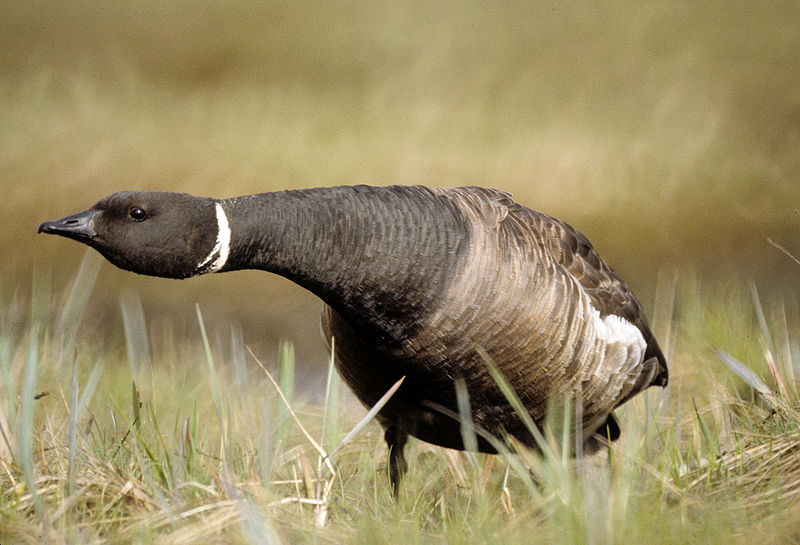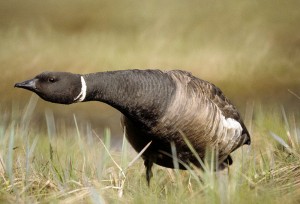From October onwards, when most of our resident wildlife is battening down the hatches to endure the impending bleak winter months, flocks of Brent Geese are very welcome visitors to Ireland. Their arduous journey to our shores is impressive for both its distance (approximately 3,000km from Arctic Canada) and the route taken: long-distance sea voyages punctuated by stop-overs in Greenland and Iceland before they reach Ireland. The necessity to escape harsh Arctic winters is very understandable. What’s not clear is why Brent geese undertake Atlantic crossings instead of following other geese species that journey south across the American continent. Whatever twist of evolutionary fate is responsible, there’s no doubt that we are lucky to receive annual visits from such intrepid voyagers.
I’m sure many Dublin residents would agree that sharing seaside walks with companiable small family groups of geese or witnessing one of the chattering fly-overs of a large flock undoubtedly brighten up an otherwise bleak winter’s day. However, a recent Irish Times article identified Brent Geese as the enemies of an unlikely foe; urban cyclists.
For more than 10 years, the S2S group has campaigned to create a continuous cycleway for 22km around Dublin Bay, running from Sandycove on the south side to Sutton on the north side which, if completed, would be Europe’s longest seafront promenade and urban cycle-path. The plan would be a great amenity for both recreational and commuter cyclists – you only have to travel along the coast road from Fairview to Howth to witness the popularity of the existing cycle path along the black banks. Just 8 km of the route remain to be completed, mostly on the south side and a single 4km stretch from Sandymount to Blackrock is particularly controversial.
The proposed route would cut through EU protected bird habitats and, in particular, affect an area of eel grass consumed by Brent Geese. The National Parks and Wildlife Service (NPWS) is also concerned about the impact of the cycle way on other bird species which reside in protected areas in Booterstown.
While I’m often wary of articles alluding to stereotypical views of “conservation hippies” thwarting sensible developments, in this case I have to agree with councillor Barry Ward that there must be a solution which “inconveniences rather than displaces” the geese. No development affecting protected habitats should be undertaken lightly. In particular, since the majority of Brent geese overwinter at just 10 sites, Birdwatch Ireland lists their conservation status as “medium concern”. However, with their current population seemingly in good health and the plethora of suitable habitat which Dublin Bay has to offer, it seems unlikely that an 8 metre wide seafront path would have a major impact on the goose population.
I’m well aware that if every development took the attitude of “there’s plenty of habitat elsewhere” then there would be no protected areas left. In addition, I must admit my vested interest in seeing the cyclepath completed – I’m a recreational (i.e. fair weather!) cyclist and live in Sutton so the availability of 22km of off-road cycling on my doorstep is a very attractive prospect. However, if you observe the behaviour of geese along the existing cycleway they seem to be remarkably unperturbed by adjacent human activity and continue to forage just below the boundary wall. Surely the same coexistent relationship between cyclists and geese could be forged south of the Liffey?
Despite including the S2S cycleway as part of their development plan councillor Barry Ward argues that management of the Dún Laoghaire Rathdown county council seems to be reluctant to develop the cycleway. Beyond the legitimate concern that the proposed cycleway would pass through a protected area, there seems to be no specific predictions or estimations that the development would have an adverse effect on the geese. Rather than an issue of cyclist vs. geese, perhaps this story is really a case of scape geese taking the blame for a council’s reluctance or inability to fund and implement a new development?
Author
Sive Finlay sfinlay[at]tcd.ie
Photo credit
wikimedia commons


